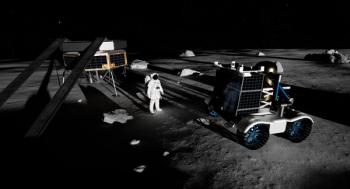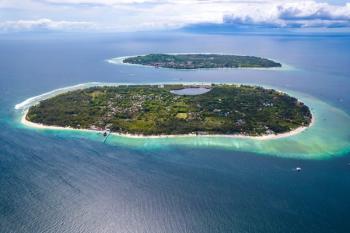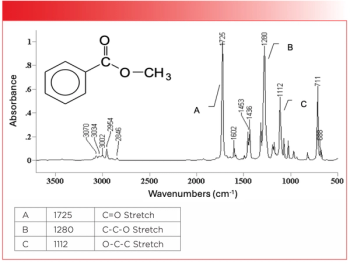
Measuring Fine Airborne Particles Within Mining Environments: An Interview with 2023 Lippincott Award Winner Peter Griffiths
In this interview, Peter Griffiths, 2023 recipient of the Ellis R. Lippincott Award, reflects over his storied career, as well as his most recent work, which focuses on measuring fine airborne particles within mining environments.
Jointly established in 1975 by The Optical Society (OSA), The Coblentz Society, and The Society for Applied Spectroscopy, the Ellis R. Lippincott Award is given out annually to recognize an individual that has made significant contributions to the field of vibrational spectroscopy. This year’s recipient, Peter Griffiths of the University of Idaho (retired) is recognized for his unique achievements and significant contributions in that field (1).
Spectroscopy spoke to Griffiths about this honor, his career in general, and, specifically, about his recent work in measuring fine airborne particles within mining environments. This interview is part of an ongoing series of interviews with the winners of awards that are presented at the annual SciX conference, which will be held this year from October 8 through October 13, in Sparks, Nevada.
Your current work entails developing an alternate method to measuring fine airborne particles within mining environments. Why is this important?
Mines (not just coal mines) usually employ several pieces of diesel-fueled heavy equipment which emit particulate matter into the air. Diesel particulate matter (DPM) is a known carcinogen. DPM has been shown to consist of organic carbon (OC) and elemental carbon (EC), with OC being the more volatile, but probably less carcinogenic, component. A knowledge of the OC and EC present in the mining environment would allow miners to evacuate the most affected sites. We are attempting to develop a small, reasonably inexpensive device to obtain this information without having to wait several days before the problem can be ameliorated.
What limitations are there with equipment currently used to measure airborne particles in the environment in question?
The current method for measuring DPM is specified by the National Institute of Occupational Safety and Heath (NIOSH) as method 5040, which is a thermal-optical method that involves first collecting the samples on a quartz-fiber filter (often over an 8-hour shift) and then transporting the collected sample and filter to a laboratory for measurement of the DPM. To quantify the OC, helium is first passed through the filter, which is held at a series of increasing temperatures to evaporate the semi-volatile OC, leaving the EC on the filter. The sweep gas is then switched to a mixture of helium and oxygen and the stepwise increase in temperature is continued until all the carbon has been burnt off. The carbon that is removed by the latter treatment is known as elemental carbon (EC). The sum of OC and EC is known as the total carbon (TC). The process of collection, transportation and measurement often takes at least a week from the time that the sample leaves the mine. Existing alternative methods based on visible/near-infrared absorption or scattering require mine and diesel-equipment-specific calibrations to quantify either OC, EC, or TC.
What benefits does your alternative method offer?
The use of mid-infrared spectroscopy (together with some sophisticated chemometrics) allows separate results for OC and EC to be obtained in a short time. For such measurements, quartz-fiber filters are precluded but poly(tetrafluoroethylene) filters are appropriate. The biggest benefit is that measurements can be made immediately after deposition; the OC and EC values can be obtained within one minute after deposition is complete.
Are there any challenges or limitations involved with using your technique?
All our measurements to date have been made in this laboratory using a bench-top Fourier transform-infrared (FT-IR) spectrometer. Samples have been acquired both in the laboratory or from several different mines (both metal and non-metal) by the program leader, Dr. David Parks, or a member of his team at NIOSH. Dr. Parks measured the spectra. Much of the data work-up was done by another consultant, Dr. Andrew Weakley. It is difficult, therefore, to discuss any problems that they have encountered (especially because they have solved most of them!). Suffice it to say that preliminary results found using a bench-top FT-IR spectrometer are very promising. To be useful, however, the instrument should be able to be mounted on, or very close to, the miner (for example, on his belt) so that the airborne EC and OC can be measured directly at the mining site, possibly using an alternative spectroscopic technique to FT-IR. The use of infrared lasers has been discarded simply because of cost. I would prefer not to discuss the approach that we are currently working on, as the initial manuscript describing our approach is still under review. I will say that every component must be small enough that the entire instrument can be mounted on a miners’ belt without interfering with his efficiency.
The separation and deposition of smaller particles is of equal importance to the spectroscopic measurement. We separate small particles from the larger ones with an impactor and this equipment also needs to be miniaturized, so that the sample can be deposited in an area of a few square millimeters to increase its thickness, and hence the infrared absorbance, of the deposited layer. All these factors can be challenges, but we are confident that they can be overcome.
Can this work translate to detecting particles in other environments?
Some, but not all, of the components that I have described above can be used or modified for other analytes; others require alternative components. For example, nanoparticulate α‑quartz, also known as respirable crystalline silica (RCS), is known to be responsible for silicosis and its measurement is probably of even greater importance than the quantification of DPM. The front end of an RCS monitor could be like that of a DPM monitor, although we have used a cyclone separator having a cut-point of 4 µm for RCS monitoring. However, the spectroscopic components would need to be changed. It has been shown that α‑quartz gives rise to a sharp doublet at about 800 cm-1 and any chemometric treatment should include this feature. This implies that samples that pass through the cyclone should not be deposited either on a PTFE or quartz-fiber filter as both materials have strongly interfering absorption bands. However, poly(vinyl chloride) filters have been shown to be suitable alternatives. Because of their resolution and sensitivity, it is probable that either an FT-IR or a quantum cascade spectrometer will be needed. Today, my money would be on FT-IR, but developments are being made on both types of spectrometers, so that I would probably not bet on one over the other.
What does your being named the recipient of the Lippincott Award mean to you professionally? Personally?
Since I am now 81 years of age and I retired over 15 years ago, this award will not benefit me professionally to any great extent. On the other hand, from a personal standpoint it is tremendously gratifying. I believe that I am the only Lippincott Awardee to have worked in his laboratory and I learned a great deal from my interaction with him. I first met him when I was a graduate student in “Tommy” Thomson’s lab at Oxford. Tommy ran a conference on far-infrared spectroscopy in 1966 that was attended by all the “names” in IR spectroscopy, including Richard (Dick) Lord and Ellis Lippincott. As is the case for many week-long conferences, Wednesday afternoon was free and my fellow “gopher”, Roger Lake, and I were asked to play a game of croquet with Lord and Lippincott. One year later, Roger was a post-doc in Dick Lord’s lab at MIT and I was in a similar position in Ellis’s lab at the University of Maryland! Learning how a successful scientist operated by observation of Ellis Lippincott was critical to my career.
What would you highlight to be the more important current developments in vibrational spectroscopy in applications or instrumentation?
Even though new FT-IR spectrometer designs are still being introduced, FT-IR is a mature field today. Historically, a slow-scanning far-infrared instrument (the Research and Industrial Instruments FS-520) became commercially available in 1964 and the first computer-controlled, laser-referenced FT-IR (the Digilab FTS-14) was announced in 1969. (I had the dubious pleasure of working with the prototypes of both instruments) While new interferometer designs are still being reported, their impact is by no means the same as, for example, the situation when the prototype FTS-14 was introduced and was in competition with well-established high-end grating spectrometers such as the Perkin Elmer 225. After a 50-year period when FT-IR spectrometers dominated the market, other instruments are starting to have an impact. For example, quantum cascade lasers have allowed good results to be obtained for certain applications where FT-IR spectrometers underperform. Several designs for spectrometers-on-a-chip have been reported but most of them have low sensitivity and resolution because their small size leads to a low-energy beam at the detector and a quantum detector (with its limited wavelength coverage) is mandated.
An application that I will single out where truly significant developments have been made in the past ten years is in infrared microspectroscopy and nanospectroscopy. First, a historical note: about 30 years ago, as I remember it, Digilab contracted with Spectra-Tech, a company who manufacture spectrometer accessories for the construction of three microscopes suitable for characterizing small samples of a few micrometers in dimension. However, their forecast of a very small potential market for IR microscopy was way off and within a year or so, an IR microscope was on the purchase order of about one-third of all FT‑IR spectrometers sold that year. The sensitivity, automation and user-friendliness of these instruments increased over the years, but their spatial resolution was still limited by diffraction to about the wavelength of the radiation (ca. 10 µm at 1000 cm-1). It was not until quite recently that a way of circumventing this limitation was announced. It was realized that in atomic force microscopy (AFM), spatial and depth resolution is governed by the sharpness of the metallictip. In practice, AFM cantilever tips with extremely fine sharpness proved difficult to make, but AFM tips that permitted a spatial resolution of about 40 nm could be fabricated routinely. The sensitivity was improved using specialized cantilever probes with an internal resonator and further improved by using QCL sources. The high repetition rate of the QCL allows absorbed infrared light to continuously excite the AFM tip at the contact resonance of the AFM cantilever. This resonance-enhanced AFM-IR, in combination with electric field enhancement from metallic tips and substrates led to the demonstration of AFM-IR spectroscopy and compositional imaging of films as thin as single self-assembled monolayers. AFM-IR has also been integrated with other sources including a picosecond optical parametric oscillator offering a tuning range from 6450 to 625 cm-1. Other techniques have been reported but the rate and number of publications on IR nanospectroscopy lead the way.
A few years ago, I attended a talk in which it was suggested that FT-IR is dead or, at least moribund. To the contrary, progress in the past decade suggests that it is likely that productive research into IR technology will continue apace.
What advice can you offer those spectroscopists starting out in their post-doctorate career?
I have found that the most successful post-docs usually work on projects that are unrelated to their dissertation research. A good PhD graduate wants to learn material with which he is initially unfamiliar rather than continuing his dissertation research. When I joined Ellis Lippincott’s group, he gave me a list of eight projects for which he had funding. (Yes, he was very good at grantsmanship!) I selected the only project that did not involve spectroscopy and have never regretted it.
At the same time, however, I would recommend that a post-doc should spend a couple of hours in the evening giving some thought to his or her future. If an academic position is the final goal, the ideal type of college environment should be considered. If a Tier 1 university is the goal, recognize that even though the department may offer generous start-up funding, they will expect to get a rapid return on their investment. (A decision on tenure and promotion to associate professor is usually made in five years or less, so that’s the time frame that you must get funding, get about ten papers published and obtain good teaching evaluations from your classes.) Teaching loads vary from department to department, and teaching more than one class per semester while setting up a successful research program can be onerous. Some universities will assign a course such as Department Seminar that require less time than large undergraduate courses, but this is not often found below Tier 1 colleges. The next question is: “How much time do you expect to work each day and how will this affect my life beyond the university?” I have two anecdotes to illustrate the importance of this.
Many years ago, I was invited to give a seminar at Texas A&M. After my seminar, I went to dinner with two of their untenured assistant professors. They related how they could tell which of them put in more hours because the only other car in the parking lot late at night was the “winner.” Years later I learned that both were divorced shortly afterwards. It takes an incredibly strong marriage to withstand that sort of pressure. On the other hand, one of my own students had superb qualifications. He co-authored more papers than any students I mentored, despite going surfing every weekend. He then studied post-doctoral at Stanford with a glowing recommendation from his advisor when the time came for job hunting. He was offered a position at one of the University of California campuses and ultimately declined to accept it because of the pressure that it would impart on his family. He decided against an academic career and is now a vice president at a pharmaceutical company. I will leave it to the reader which of these three people made the right decision.
The main recommendation that I will leave you with is to select a postdoctoral position with which you are comfortable and a project that interests and excites you. Your next position will determine your future success.
Reference
(1) Optica. Peter R. Griffiths Named the 2023 Ellis R. Lippincott Award Recipient. Optica 2023.
About the Interviewee
Newsletter
Get essential updates on the latest spectroscopy technologies, regulatory standards, and best practices—subscribe today to Spectroscopy.




